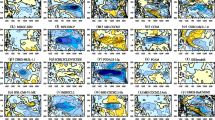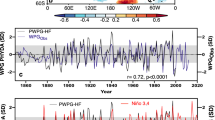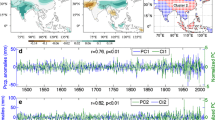Abstract
Using the Paleoclimate Modeling Intercomparison Project Phase 2 (PMIP2), we investigate Pacific Decadal Oscillation (PDO) variability during the Mid-Holocene (6,000 years ago), especially maintenance of the PDO variability during the mid-Holocene despite reduced El Nino-Southern Oscillation (ENSO) activity. Most of the models participating PMIP2 identified the reduced ENSO activity during the mid-Holocene, but essentially little difference in PDO variability between the pre-industrial and mid-Holocene periods. Through multiple regression and partial correlation analysis, we found that the influence of the ENSO on the PDO was reduced due to reduced ENSO activity, but that the influence of local atmospheric circulation (Aleutian Low; AL) was enhanced during the mid-Holocene even though the variability of AL itself did not change much between the mid-Holocene and the present. That is, the reduction in PDO activity due to the weaken ENSO is offset by the enhanced PDO attributable to the intensified influence of the AL. As a result, the PDO variability during the mid-Holocene was as active as that during the pre-industrial era.







Similar content being viewed by others
References
Alexander MA, Deser C (1995) A mechanism for the recurrence of wintertime midlatitude SST anomalies. J Phys Oceanogr 25:122–137
Alexander MA, Deser C, Timlin MS (1999) The re-emergence of SST anomalies in the North Pacific Ocean. J Clim 12:2419–2431
Alexander MA, Bladé I, Newman M, Lanzante JR, Lau N-C, Scott JD (2002) The atmospheric bridge: the influence of ENSO teleconnections on air–sea interaction over the global oceans. J Clim 15:2205–2231
An S-I, Wang B (2005) The forced and intrinsic low-frequency modes in the North Pacific. J Clim 18:876–885
Barron JA, Anderson L (2011) Enhanced late holocene ENSO/PDO expression along the margins of the eastern North Pacific. Quat Int 235:3–12
Braconnot P et al (2007) Results of PMIP2 coupled simulations of the mid-holocene and last glacial maximum—part 1: experiments and large-scale features. Clim Past 3:261–277
Brown J, Tudhope AW, Collins M, McGregor HV (2008) Mid-Holocene ENSO: issues in quantitative model-proxy data comparisons. Paleoceanography 23:PA3202. doi:10.1029/2007PA001512
Chiang JCH, Fang Y, Chang P (2009) Pacific climate change and ENSO activity in the mid-holocene. J Clim 22:923–939
Clement AC, Seager R, Cane MA (2000) Suppression of El Nino during the mid-Holocene by changes in the earth’s orbit. Paleoceanography 15:731–737
Fisler J, Hendy IL (2008) California current system response to late holocene climate cooling in southern California. Geophys Res Lett 35:L09702. doi:10.1029/2008GL033902
Friddell JE, Thunell RC, Guilderson TP, Kashgarian M (2003) Increased northeast Pacific climate variability during the warm middle holocene. Geophys Res Lett 30. doi:10.1029/2002GL016834
Gordon C, Cooper C, Senior CA, Banks H, Gregory JM, Johns TC, Mitchell JFB, Wood RA (2000) The simulation of SST, sea ice extents and ocean heat transport in a version of the Hadley Centre coupled model without flux adjustments. Clim Dyn 16:147–168
Hoskins BJ, Karoly DJ (1981) The steady state response of a spherical atmosphere to thermal and orographic forcing. J Atmos Sci 38:1179–1196
Isono D, Yamamoto M, Irino T, Oba T, Murayama M, Nakamura T, Kawahata H (2009) The 1500-year climate oscillation in the midlatitude North Pacific during the holocene. Geology 37:591–594
Jacob RL, Schafer C, Foster I, Tobis M, Anderson J (2001) Computational design and performance of the fast ocean-atmosphere model, ver. 1. In: Alexandrov VN, Dongarra JJ, Juliano BA, Renner RS, Tan CJK (eds) Proceedings of the international conference on computational science (ICCS), LNCS 2073. Springer, Heidelberg, pp 175–184
K-1 Model Developers (2004) K-1 coupled model (MIROC) description. Technical report 1, Center for Climate System Research, University of Tokyo
Kim J-H, Rimbu N, Lorenz J, Lohmann G, Nam S-I, Schouten S, Ruhlemann C, Schneider RR (2004) North Pacific and north Atlantic sea-surface temperature variability during the holocene. Quat Sci Rev 23:2141–2154
Koutavas A, Demenocal B, Olive GC, Lynch-Stieglitz J (2006) Mid-holocene El Nino-Southern Oscillation (ENSO) attenuation revealed by individual foraminifera in eastern tropical Pacific sediment. Geology 34:993–996
Kumar A, Leetmaa A, Ji M (1994) Simulations of atmospheric variability induced by sea surface temperatures and implications for global warming. Science 266:632–634
Kutzbach JE (1981) Monsoon climate of the early Holocene: climate experiment with the earth’s orbital parameters for 9000 years ago. Science 214:59–61
Latif M, Barnett TP (1996) Decadal climate variability over the North Pacific and North America: dynamics and predictability. J Climate 9:2407–2423
Lau N-C, Nath MJ (1994) A modeling study of the relative roles of tropical and extratropical SST anomalies in the variability of the global atmosphere-ocean system. J Clim 7:1184–1207
Liu Z, Kutzbach J, Wu LX (2000) Modeling climate shift of El Nino variability in the holocene. Geophys Res Lett 27:2265–2268
Liu Z, Harrison SP, Kutzbach J, Otto-Bliesner B (2004) Global monsoons in the mid-holocene and oceanic feedback. Clim Dyn 22:157–182
Mantua NJ, Hare SR, Zhang Y, Wallace JM, Francis RC (1997) A Pacific decadal climate oscillation with impacts on salmon. Bull Am Meteorol Soc 78:1069–1079
Marti O et al. (2005) The new IPSL climate system model: IPSL-CM4. Technical report, Institut Pierre Simon Laplace des Sciences de l’Environnement Global IPSL Case101 4 place Jussieu Paris France
McGregor HV, Gagan MK (2004) Western Pacific coral δ18O records of anomalous holocene variability in the El Nino-Southern oscillation. Geophys Res Lett 31:L11204. doi:10.1029/2004GL019972
Meyers SD, Melsom A, Mitchum GT, O’Brien JJ (1998) Detection of the fast Kelvin wave teleconnection due to El Niño—southern oscillation. J Geophys 103:27655–27663
Nelson DB et al (2011) Drought variability in the Pacific Northwest from a 6,000-yr lake sediment record. PNAS 108:3870–3875
Newman M, Compo GP, Alexander MA (2003) ENSO-forced variability of the Pacific decadal oscillation. J Clim 16:3853–3857
Nigam S, Guan B, Ruiz-Barradas A (2011) Key role of the Atlantic multidecadal oscillation in 20th century drought and wet periods over the Great Plains. Geophys Res Lett 38:L16713. doi:10.1029/2011GL048650
Otto-Bliesner BL (1999) El Nino/La Nina and Sahel precipitation during the middle holocene. Geophy Res Lett 26:87–90
Otto-Bliesner BL, Brady EC, Shin S-I, Liu ZX, Shields C (2003) Modeling El Nino and its teleconnections during the last glacial-interglacial cycle. Geophys Res Lett 30:2198. doi:10.1029/2003GL018553
Pierce DW, Barnett TP, Latif M (2000) Connections between the Pacific Ocean Tropics and midlatitudes on decadal timescales. J Clim 13:1173–1194
Rein B, Luckge A, Reinhardt L, Sirocko F, Wolf A, Dullo WC (2005) El Nino variability off Peru during the last 20,000 years. Paleoceanography 20:PA4003. doi:10.1029/2004PA001099
Rodbell DT, Seltzer GO, Anderson DM, Abbott MB, Enfield DB, Newman JH (1999) An ~ 15,000-year record of El Nino-driven alleviation in southwestern Ecuador. Science 283:516–520
Schneider N, Cornuelle BD (2005) The forcing of the Pacific decadal oscillation. J Clim 18:4355–4373
Smith TM, Reynolds RW (2004) Improved extended reconstruction of SST (1854–1997). J Clim 17:2466–2477
Stone JR, Fritz SC (2006) Multidecadal drought and Holocene climate instability in the Rocky Mountains. Geology 34:409–412
Tian J, Nelson DM, Hu FS (2006) Possible linkages of late-holocene drought in the North American midcontinent to Pacific decadal oscillation and solar activity. Geophys Res Lett 33:L23702. doi:10.1029/2006GL028169
Timm O, Timmermann A (2007) Simulation of the last 21,000 years using accelerated transient boundary conditions. J Clim 20:4377–4401
Tranberth KE, Hurrel JW (1994) Decadal atmospheric-ocean variations in the Pacific. Clim Dyn 9:303–319
Tudhope AW et al (2001) Variability in the El Nino-Southern oscillation through a glacial-interglacial cycle. Science 291:1511–1517
Yu Y, Zhang X, Guo Y (2004) Global coupled ocean–atmosphere general circulation models in LASG/IAP. Adv Atmos Sci 21:444–455
Yukimoto S, Noda A (2002) Improvements of the Meteorological Research Institute Global Ocean–atmosphere coupled GCM (MRI-CGCM2) and its climate sensitivity. Technical report 10 NIES Japan
Zheng W, Braconnot P, Guilyardi E, Merkel U, Yu Y (2008) ENSO at 6 ka and 21 ka from ocean–atmosphere coupled model simulations. Clim Dyn 30:745–762
Acknowledgments
We acknowledge the international modeling groups for providing their data for analysis, and the Laboratoire des Sciences du Climat et de l’Environnement (LSCE) for collecting and archiving the model data. More information is available on http://pmip2.lsce.ipsl.fr/. This work was funded by the Korea Meteorological Administration Research and Development Program under Grant CATER 2012-3043.
Author information
Authors and Affiliations
Corresponding author
Rights and permissions
About this article
Cite this article
An, SI., Park, JH. Maintenance of PDO variability during the mid-holocene in PMIP2. Clim Dyn 40, 1291–1299 (2013). https://doi.org/10.1007/s00382-012-1445-6
Received:
Accepted:
Published:
Issue Date:
DOI: https://doi.org/10.1007/s00382-012-1445-6




